![]() 1st Battalion 22nd Infantry
1st Battalion 22nd Infantry ![]()
Charles W. Temple
22nd US Infantry
Biography
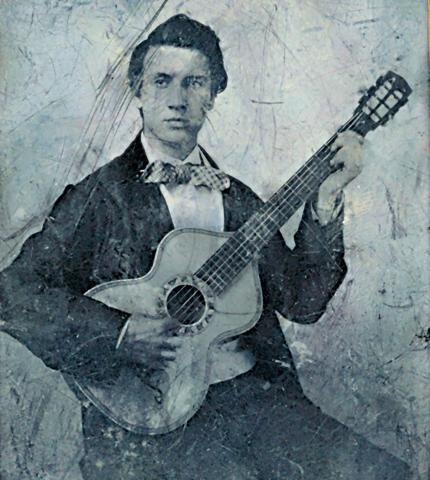
Charles W. Temple -
photograph taken when he was about 20-25 years old
( circa 1858-1863 )
Charles W. Temple served in the
22nd Infantry from 1881 - 1903.
Thanks to the efforts of his great-great nephew Carl R. Bryon
his story has been preserved and the mementos of his service
have been on display with the presently serving Battalions of the
22nd Infantry Regiment.
FAMILY MEMOIR
Regarding Charles Wood Temple
or "Great Uncle Charlie"
by
his Great Great-Nephew Carl R. Byron
(with additions by the website editor)
Charles W. Temple was born March 7,1838; one of
eight children; seven which survived into adulthood.
He was a younger brother of my great grandfather, Albert H.
Temple, who was born in 1832 and died in 1920.
For some reason lost in the mists of time
Charlie joined the Confederate army in July 1861.
Records conflict on his service; his gravestone states he was in
the "1st Mississippi Brigade" while his published
obituary (1908)
says he was with the "1st Louisiana Regiment."
His obituary claims he was a bachelor, however
family records indicate that Charles W. Temple married a Miss.
Ella Vache' in 1870.
She either passed away or they separated/ divorced rather
quickly; for in 1876 Charles W. Temple enlisted in the US Army.
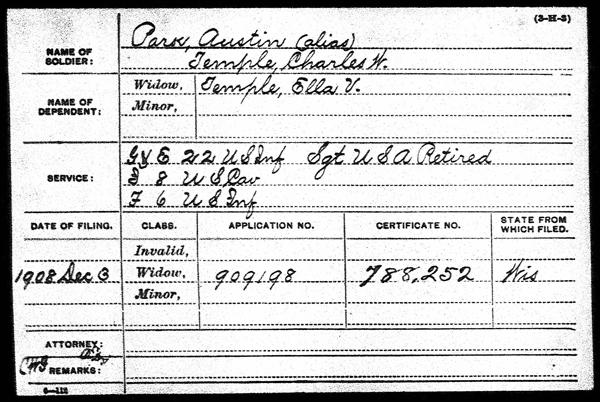
Above: The application card for a pension for the service of Charles W. Temple.
Note the application is filed under the
name of Austin Park which was the alias Temple used for his
military career with the United States Army.
The application was filed by his widow Ella V. Temple in December
1908, a few months after Charles Temple's death. Ella Vache
married
Charles W. Temple in 1870 and they had three children. The card
lists Temple's service in Companies G and E
of the 22nd Infantry, Company I of the 8th Cavalry and Company F
of the 6th Infantry.
In 1897-98 Charlie, presumably while on Army
leave, helped his brother, Albert Temple, build a family
homestead
in the small Western Massachusetts town of Colrain. Albert had
moved there in 1865 after having had his store in Falls Church,
VA; burned out
or ransacked by forces of each side during the Civil War.
Charlie's nephew; Roscoe W. Temple, Albert's son and a young man
of about 20
helped as well. Roscoe was my grandfather and lived the remainder
of his life in the home he helped build;
dying of old age there on November 6,1960.
Only one of the homestead's four upstairs
bedrooms—Charlie's—had "Southern," or
"hard" pine flooring, the others were plain soft pine
boards.
He paid extra. [The lumber and other materials to construct the
nine-room two-story house cost just under $5,000.
Of course the average laborer wage was $l-2.00/day].
Unfortunately, shortly after Charlie retired in 1904 he developed
cancer of the throat or esophagus;
likely due to 40+ years of cigar smoking and drinking. He spent
his last months more and more confined to his bedroom
before being taken to the local hospital where he passed away in
1908.
I was raised in the Old Homestead during the
1950's and first half of the 1960's.
I inherited the property in late 1973 and returned to it in 1974.
The house had been wired for electricity circa 1911, so needless
to say it was in need of updating.
In the midst of that process in 1975 or 76 I lifted up a plank at
the top of the attic stairs;
intending to toss electrical cable down between the stringers to
start (re)-wiring the upstairs bedrooms.
To my utter amazement the bay between the two stringers was
completely filled with turn-of-the-20th Century whiskey bottles
(corks, no screw tops) for almost three feet! There were 30-to-40
pint or fifth bottles; perhaps more.
Then it dawned on me. Charlie's brother—my Great
Grandfather—was "Deacon" Temple.
He'd been a Deacon of the Colrain Congregational Church for
decades and most proud of it.
And, Great Grandmother was a Charter Member of the Congregational
Church's Women's Christian Temperance Union
(the signed circa-1880 charter is also in the "family
trunk.").
Dumping his empty whiskey bottles under the attic floor rather
than face his brother's disapproval
and sister-in-law's Righteous Wrath was most likely the
"lesser of the evils" for Charlie—particularly as
the constant pain from his cancer increased.
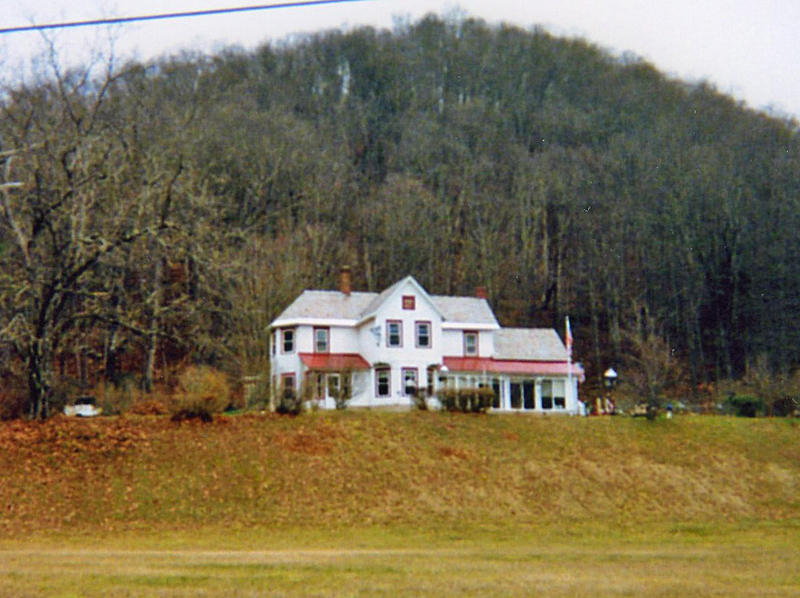
The Temple homestead near Colrain,
Massachusetts which Charles Temple helped to build while on leave
from the Army. Temple returned here to live upon his retirement
in 1904.
Photo courtesy of Les Chadwick
When in the Philippines circa 1900 Charles
Temple wrote several letters home about that far-distant land.
When he returned to Colrain in 1904-or-05 he brought with him two
pieces of highly embroidered and decorated cloth.
According to the family story, these two pieces were the ends of
an altar cloth which he rescued from a bombed out church in
Manila.
My mother, as a 6 grade schoolteacher, dutifully brought the
cloths to class every year for over 30-years as she taught her
students—
including me circa 1960 [it was a small town]—about the
Spanish-American War.
I stumbled onto these cloths around 1990 and decided to take them
to the fabric department of the Museum of Fine Arts in Boston
to see if I could learn anything more about them. When I returned
to the museum to pick them up the archivist was clearly nervous.
Finally I said, "OK, What's the story?" He hesitantly
responded, "I know your family history says these decorated
cloths are Altar Cloths.
However, I'm rather embarrassed to inform you that the cut,
design, and decoration of this material clearly indicate
they are part of a Flamingo Dancer's DRESS!!!!
After a long laugh I told the archivist to
relax, I wasn't upset, in fact, I thought it was absolutely
wonderful.
If Charlie was having a good enough time with a flamingo dancer
in Manila at age 60
to end up with a couple of pieces from her dress, GOD BLESS HIM!!
My aunt, then in her 80's agreed. However we both knew that my
mother would have been another story......
Sincerely,
Carl R. Byron
Below is a scan of the original
newspaper article, as it appeared in the Greenfield
Recorder in 1905,
announcing the retirement of Charles W. Temple.
Following the article is a typed transcription of its contents.


A VETERAN OF MANY WARS.
____________________________
A FRANKLIN COUNTY SOLDIER.
Served in Confederate Army, Fought Indians for "Uncle
Sam" and Went to the Philippines—Ashfield and the
Automobile
From Our Special Correspondent.
GREENFIELD, Saturday, June 17.
Charles W. Temple, a soldier of many wars, who
is now at the home of his nephew, Clarence L. Brigham, at Elm
Grove,
is a brother of the well-known in-spirational speaker, Mrs. Helen
Temple Brigham, and of Dea A. H. Temple of Colrain.
At the age of 67 Mr Temple has laid aside the sword which he
wielded for many years for the weapons of peace,
and looks forward to spending his days in Colrain. He enjoys the
distinction of having fought on the losing side during the civil
war,
and after that conflict had been brought to an end by the
surrender of Lee to Grant, of donning the United States uniform
and serving his country in various regiments and climes until he
was mustered out at Fort Leavenworth, October 18, 1904.
Born at Manchester, Vt., the son of Jabez Temple, who died at Elm
Grove, Mr Temple enlisted in the 1st Louisiana regiment in July,
1861,
under Charles Dreux, the first confederate officer to be killed
in the war. In the second battle of Bull Run,
Mr Temple's horse was shot under him, and his foot injured by the
horse falling on it.
While pinioned down by the weight of. the animal, which he could
not move, he heard some one call "Say, Johnny, can't you
roll over here?"
It proved to be a Yankee officer whose knee cap had been
shattered. As neither could move far enough
to join forces for making themselves as comfortable as possible,
they were relieved to see a soldier approaching.
Mr Temple appealed to the newcomer for aid in rolling the horse
off his leg, and the "Johnny" , wounded as he was in
one hand,
managed to" "bring a rail and release his injured
comrade in arms. The Yankee officer and Mr Temple then managed to
get together
and make themselves more comfortable than they had been. Their
good Samaritan, George by name, helped them, brought water,
covered them with a blanket, and brought some brush for shade.
The "Yank" happened to be Capt Gregory of the 20th New
York, who died that night.
Before leaving, George kept looking wistfully at the wounded
officer; went away a short distance,
and then returned as though drawn by some hidden, invisible
force. Capt Gregory surmised what was in George's mind
when he asked to see his watch, a silver timepiece of slight
value, but valuable in the sight of the rebel.
Finally he took the watch, after asking the owner what time it
was, went away a short distance with it in his hand, came back,
handed it to Capt Gregory, took it again and walked slowly off,
as though his mind were made up to keep it.
But George's inward monitor was ticking away like the watch, and
he was uneasy in mind.
At last he came back and said: "Here, 'Yank,' take your
d——d old watch, I wouldn't be tempted so again for
$1000."
Mr Temple was picked up after a day or two by Virginia farmers,
who lived where the Hackleys resided,
and he is acquainted with people Hugh Hackley of this town knows.
Following the fortunes of the confederacy
Mr Temple had interesting experiences, and while on the staff of
Gen D. H. Hill, chief of the signal corps,
came into contact with many of the leading rebel generals like
Jackson, Longstreet, Gordon, Magruder, and others.
He was for a time on the staff of Gen A. P. Hill, who was killed
at the capture of Petersburg.
In the crucial battle of Gettysburg he was on the staff of Gen
Carnot Posey, in Anderson's division.
In 1875 Mr Temple joined the 8th cavalry under Col Gregg in
Arizona. For 10 years he fought Indians under various generals,
including Reno and Miles. While on the plains he met many
well-known men, like Frederick Remington and Charles King.
Mr Temple has many recollections of Gen Charles Devens, under
whom he served in Texas.
In 1899 he went to the Philippines with the 22d regiment, and
re-enlisted after the expiration of his first enlistment.
When he retired he was first sergeant. His ancestors have been
fighting men for generations,
and his brother, “Deacon” A.H. Temple has the queen's
arm that their great-grandfather carried at the battle of Bunker
Hill.
On the weapon are the initials of a British soldier from whom it
was captured.
Now Mr Temple is passing the time peacefully in the happy valley
at Elm Grove, and spends part of his time painting in oils.
He has gathered many curios in his travels. He is erect and
soldierly in his bearing, and physically pretty well preserved.
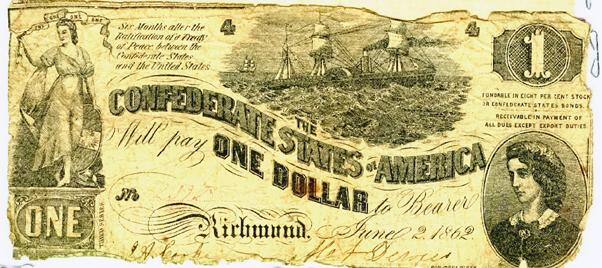
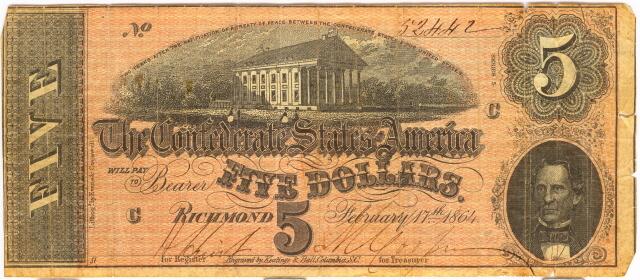
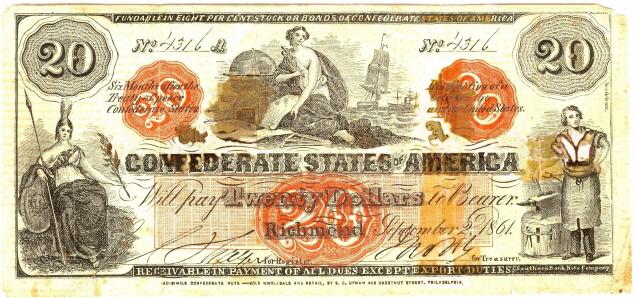
Above is Confederate money which was among the possessions of Charles Temple
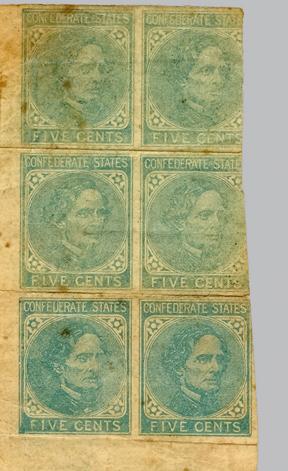
Above are Confederate postage stamps which were among the possessions of Charles Temple
**********************
The grave of Charles W. Temple reads: "Mississippi Brigade, CSA; 8th & 22nd Infy Reg, 1876-1904."
The service of Charles W. Temple
in the Confederate States Army is of historical significance.
He joined the CSA in July 1861, as part of LT Colonel Charles
Dreux's 1st Battalion Louisiana Volunteers.
Commonly known as Dreux's Battalion, this organization consisted
of the first volunteer companies to respond to Louisiana's call
for troops
and was said to be made up of New Orleans finest gentlemen. In
June, 1861, five Louisiana companies stationed at Pensacola,
Florida,
were mustered into service for twelve months as the 1st
Battalion, Louisiana Volunteers, with a sixth company added in
July.
Charles D. Dreux was elected lieutenant-colonel of the battalion
and served until he was killed in a skirmish on July 5, 1861.
Colonel Dreux was the first Louisianan and the first Confederate
field officer killed in the war.
Serving as he did on several
Generals Staffs of the Confederate Army must have given Charles
Temple
an extraordinary vantage point of participation in the Civil War.
The "Mississippi Brigade" inscribed on his grave is
probably a reference to his service
on the General Staff of Brigadier General Carnot Posey at the
battle of Gettysburg.
Posey led a Brigade of four Mississippi Regiments from November
of 1862 until he was wounded
in October of 1863, dying from infection of the wound a month
later.
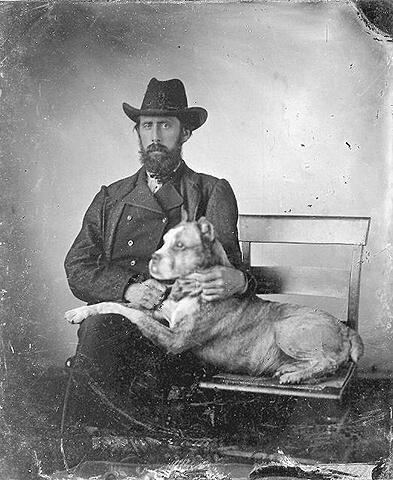
Studio portrait of Charles W. Temple
taken circa 1876-1881.
He is wearing a US Army issue black campaign hat and medium blue
overcoat.
Photo believed to have been taken while he was a member of the
8th US Cavalry.
Charles W. Temple served in the United States
Army from 1876 to 1904. The following is a synopsis of his
service record as taken from his enlistment records
and the monthly Returns of the 8th Cavalry and the 22nd and 6th
Infantry. In between all entries listed below it can be assumed
that he was with his assigned Company
on whatever duty it was performing at that particular time.
Charles W. Temple enlisted in the Army under
the name of Austin Park for service in the Cavalry on November
18, 1876 at Philadelphia, Pennsylvania.
For the next twenty-eight years Temple served in the Army under
the alias of Austin Park.
His enlistment record in 1876 indicated he was
31 years old, stood 5 feet 7 ¾ inches tall, had grey eyes, brown
hair and a dark complexion.
He listed his place of birth as Baltimore, Maryland and his
previous occupation as Painter.
He was assigned to Company I of the 8th Cavalry
at Fort Brown, Texas in December 1876. He was one of 250 recruits
who were assigned to the 8th Cavalry that month
as part of a long awaited influx of soldiers needed to fill out
the ranks of the Regiment. The exact date of when he joined his
Company is unknown as he was one
of over 40 recruits recorded as being assigned “between
December 8 and 16, 1876.” In the monthly Returns of the 8th
Cavalry the term “Company” is used
interchangeably with the term “Troop.”
During his time with the 8th Cavalry the
Regiment was stationed in Texas at various forts and locations
from Fort Brown, near the mouth of the Rio Grande,
to Fort Hancock, near El Paso. Its duties included keeping an eye
on Indian reservations, escorting wagon trains, conducting
scouting patrols to watch for
smugglers and cattle thieves and garrison duty at various forts
and camps.
During March 1879 he was noted as being part of a detachment from his Company on scouting duty. The location of this duty was given as "In the field."
In the Return for May 1881 he was noted as
being on Detached Service at Fort Clark, Texas beginning on May
15. In the Returns for June and July
he was noted as still being on this duty but the beginning date
was changed to May 17. In the Return for August the entry for him
read as being on
Special Duty at Fort Clark with a beginning date of May 17. The
Returns for September and October noted this duty as being
Special Duty in the
Quartermaster Department at Fort Clark with a beginning date of
May 17.
He was discharged from Company I 8th Cavalry as
his enlistment expired on November 17, 1881 at Fort Clark, Texas.
His rank at discharge
was Private and his character rating was Good.
On November 25, 1881 he enlisted in the 22nd Infantry at San Antonio, Texas.
He was assigned to Company G 22nd Infantry at Fort Clark, Texas with the rank of Private on November 26, 1881.
From October 16-19, 1882 he was absent with leave.
From June 27 to July 22, 1885 he was on Detached Service at Ft. Lewis, Colorado.
On an unknown date between July 1885 and October 1886 he was promoted to Corporal.
From October 9-19, 1886 he was on a hunting expedition at an unspecified location.
He was discharged from this enlistment on
November 24, 1886 because of Expiration of Service at Fort Lewis,
Colorado. His rank at the time of discharge
was Corporal and he had a character rating of Very Good.
He was reenlisted in Company G 22nd Infantry on
November 25, 1886 with the rank of Corporal at Fort Lewis,
Colorado by
Captain Charles W. Miner who was the Commanding officer of
Company G.
The Return of the 22nd Infantry for the month
of November 1886 indicates he was now entitled to $3 per month
extra
for having served 10 continuous years in the Army.
On November 28, 1886 he went on furlough. The
location of his furlough was recorded as being "beyond the
limits of the Division" which meant
beyond the Division of the Missouri. The Division of the Missouri
encompassed the area of Arkansas, Nebraska, Iowa, Kansas,
Minnesota,
Dakota Territory, Montana Territory, Wyoming Territory, Colorado
Territory, Utah, Indian Territory (Oklahoma) and New Mexico.
In December 1886 while still on furlough he was promoted to Sergeant. He remained on furlough until May 11, 1887.
From 1881 to 1888 he and his Regiment were
stationed at various forts and camps in Colorado and Texas mostly
performing garrison duties.
Long marches were undertaken from time to time as elements of the
Regiment were moved around on the lookout for disturbances among
the Ute and Navajo Indians. Other duties took the 22nd Infantry
as far as Utah and the Indian Territory (Oklahoma) involving long
marches and travel by railroad.
In 1888 the 22nd Infantry moved to the
Department of the Dakotas where it was headquartered at Fort
Keogh, Montana. He and his Company
were at times also stationed at Fort Totten and then Fort Yates
in North Dakota. Primary among their duties was keeping an eye on
the vast Sioux
and Cheyenne reservations in case of trouble. He took part with
his Company in the final campaign of the Indian Wars, the Pine
Ridge Campaign.
He was discharged from this enlistment on
November 24, 1891 because of Expiration of Service at Fort Keogh,
Montana. His rank at the time of discharge
was Sergeant and he had a character rating of Excellent.
On November 25, 1891 he was reenlisted in
Company G 22nd Infantry as a Sergeant at Fort Keogh, Montana by
1st Lieutenant Robert N. Getty
who was the Regimental Quartermaster of the 22nd Infantry.
On November 28, 1891 he went on furlough at an unspecified location. He remained on furlough until May 27, 1892.
On October 25, 1893 he was reduced in rank to
Private and transferred to Company E 22nd Infantry
by 22nd Infantry Headquarters Orders # 44 of the same date at
Fort Keogh.
From March 31 to April 6 of 1895 he was one of seven soldiers from Company E as guards on Court Martial Duty at Fort Snelling, Minnesota.
At an unknown date between April 1895 and November 1896 he was promoted back to Sergeant.
He was discharged from this enlistment on
November 24, 1896 because of Expiration of Service at Fort Crook,
Nebraska.
His rank at the time of discharge was Sergeant and he had a
character rating of Very good.
On November 25, 1896 he was reenlisted in Company E as a Sergeant at Fort Crook, Nebraska by 1st Lieutenant Herman Hall of Company H 22nd Infantry.
From November 27 to December 6, 1986 he was on furlough at Cincinnati, Ohio.
From March 7 to May 6, 1897 he was on furlough "in the United States."
At an unknown date between May 1897 and April 1898 he was reduced in rank to Private.
From April 18 to September 19, 1898 he was on
Detached Service at Fort Crook, Nebraska. When the 22nd Infantry
moved to
Tampa, Florida that April to prepare to sail to Cuba two enlisted
men from each Company were assigned to remain at Fort Crook
under the command of an officer from the 22nd Infantry as guards
for the Fort and the possessions of the Regiment. Thus he did not
deploy
with his Company to Cuba during the War with Spain.
At an unknown date between September and December 1898 he was promoted to Corporal.
He went with Company E 22nd Infantry on their
deployment to the Philippines, arriving there in March 1899. He
took part in many battles
and engagements against insurgent forces on the Island of Luzon.
He was discharged from this enlistment on
November 24, 1899 because of Expiration of Service at Candaba,
Philippine Islands.
His rank at the time of discharge was Corporal and he had a
character rating of Excellent.
On November 25, 1899 he was reenlisted in
Company E as a Corporal at Candaba, Philippine Islands by Captain
Henry C. Hodges
who at the time was the Commanding Officer of Company H 22nd
Infantry.
From November 25 to December 3, 1899 he was absent with leave at Manila, Philippine Islands.
At an unknown date between December 1899 and July 1900 he was promoted to Sergeant.
From July 13 to August 14, 1900 he was at Arayat, Philippine Islands on Detached Service.
On November 27, 1900 he was admitted sick into
the 1st Reserve Hospital in Manila, Philippine Islands. His
illness was severe enough
for him to be sent home to the United States. On January 7, 1901
he was admitted into Letterman General Hospital at the Presidio
in San Francisco, California directly from the transport U.S.A.T.
Sherman. He remained in the hospital at the Presidio until
September 21, 1901.
From June 2 to July 2, 1902 he was absent sick from his Company at Fort Crook.
From September 5 to October 22, 1902 he was absent sick from his Company at Fort Crook.
He was discharged from this enlistment on
November 24, 1902 because of Expiration of Service at Fort Crook,
Nebraska.
His rank at the time of discharge was Sergeant and he had a
character rating of Excellent.
On November 28, 1902 he was reenlisted in
Company E as a Private at Fort Crook, Nebraska by Captain Robert
L. Hamilton
who at the time was assigned as the Regimental Adjutant of the
22nd Infantry.
On November 30, 1902 he went on furlough at Elm Grove, Massachusetts.
While still on furlough in December 1902 he was promoted to Corporal.
He remained on furlough until February 27, 1903 when he rejoined Company E at Fort Crook.
From April 28 to May 3, 1903 he was on Detached Service at Fort Crook.
On October 6, 1903 he was transferred to the
6th Infantry as a Corporal according to Paragraph 5 Special
Orders # 191
of the Department of the Missouri.
He was assigned to Co F 6th Infantry on October
6, 1903 at Ft Leavenworth, Kansas as one of eight enlisted men
transferred to the 6th Infantry
from the 22nd Infantry during the month of October 1903.
He served in the 6th Infantry at Fort
Leavenworth for a year on garrison duty and was retired from the
Army at Fort Leavenworth on October 18, 1904
with the rank of 1st Sergeant under paragraph 3 Special Orders #
241 of the War Department dated October 13, 1904.
He has two enlistment records for the year
1902, one under the name of Austin Park and one under the name of
Charles W. Temple.
The final entry under the one for Austin Park indicates that his
name was changed to Charles W. Temple.
The final entry under the one for Charles W. Temple indicates he
was retired as 1st Sergeant and that his name was changed from
Austin Park.
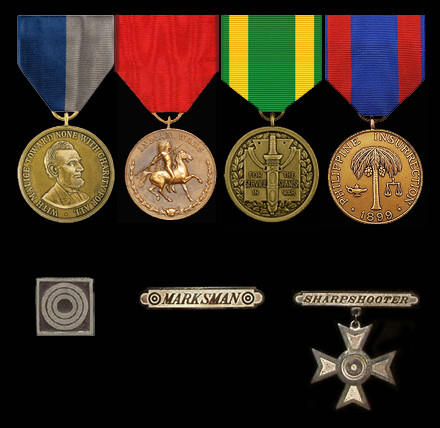
Charles W. Temple's decorations
Top left to right: Civil War Campaign
Medal, Indian Wars Campaign Medal,
Spanish War Service Medal, Philippine Campaign Medal
Bottom left to right: Marksman award collar button, Marksman breast badge, Sharpshooter breast badge
Home | Photos | Battles & History | Current |
Rosters & Reports | Medal of Honor | Killed
in Action |
Personnel Locator | Commanders | Station
List | Campaigns |
Honors | Insignia & Memorabilia | 4-42
Artillery | Taps |
What's New | Editorial | Links |